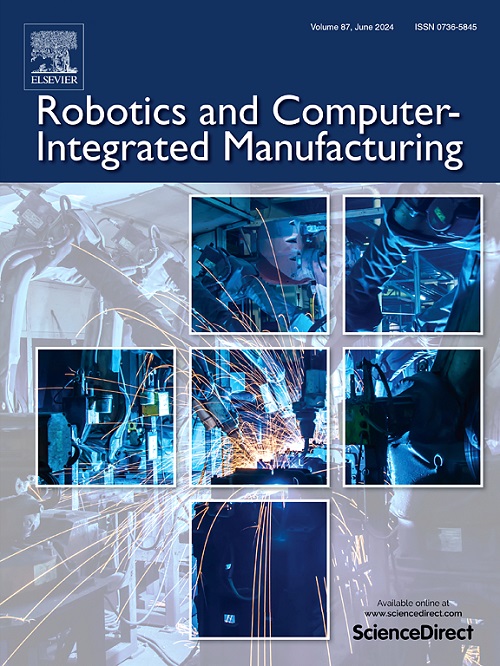A green and efficient disassembly line balancing with human-robot collaboration and destructive disassembly
IF 11.4
1区 计算机科学
Q1 COMPUTER SCIENCE, INTERDISCIPLINARY APPLICATIONS
引用次数: 0
Abstract
Human-robot collaboration combines the strengths of both humans and robots to enhance disassembly line efficiency. Considering the indivisibility and recovery value of certain components, this study incorporates destructive disassembly into a human-robot collaborative disassembly line. A mixed-integer linear programming model of the disassembly line balancing problem is constructed. The model accounts for task precedence relationships, task attributes, disassembly modes, human-robot collaboration, and the configuration of humans and robots. The objective is to minimize cycle time, smoothness index, and disassembly energy consumption while maximizing disassembly profit. The algorithm uses a three-layer encoding strategy based on task sequence, task operators, and disassembly modes, with an optimization-driven initialization to improve the initial solution quality. Five selection strategies and two neighborhood search strategies are designed, and during the iterative process, the strategy is dynamically adjusted through Q-learning to enhance both global search and local search capabilities. The effectiveness and superiority of the proposed algorithm are validated through three types of test case experiments, compared with the five latest algorithms. Finally, the model and algorithm are applied to a real-world laptop disassembly case. The results show that the introduction of collaborative robots in disassembly significantly reduces disassembly costs. Compared to manual disassembly, the cycle time of the disassembly line can be reduced by 24.39%, and idle time can be reduced by 33.64% in the human-robot collaborative disassembly mode. Compared to non-destructive disassembly, destructive disassembly can reduce energy consumption by 28.20%.

一条人机协作与破坏性拆卸相平衡的绿色高效装配线
人机协作结合了人与机器人的优势,提高了装配线的效率。考虑到某些部件的不可分割性和回收价值,本研究将破坏性拆卸纳入人机协同拆卸线。建立了装配线平衡问题的混合整数线性规划模型。该模型考虑了任务优先级关系、任务属性、拆卸模式、人机协作以及人与机器人的配置。目标是最小化周期时间、平滑度指数和拆卸能耗,同时最大化拆卸利润。该算法采用基于任务序列、任务算子和拆卸模式的三层编码策略,并采用优化驱动的初始化,提高了初始解的质量。设计了5种选择策略和2种邻域搜索策略,并在迭代过程中通过q学习动态调整策略,增强了全局搜索和局部搜索能力。通过三种类型的测试用例实验验证了该算法的有效性和优越性,并与五种最新算法进行了比较。最后,将该模型和算法应用于实际的笔记本电脑拆卸案例。结果表明,在拆卸中引入协作机器人可显著降低拆卸成本。与人工拆卸相比,人机协同拆卸可减少24.39%的拆卸线周期时间,减少33.64%的空闲时间。与非破坏性拆卸相比,破坏性拆卸可减少28.20%的能耗。
本文章由计算机程序翻译,如有差异,请以英文原文为准。
求助全文
约1分钟内获得全文
求助全文
来源期刊
CiteScore
24.10
自引率
13.50%
发文量
160
审稿时长
50 days
期刊介绍:
The journal, Robotics and Computer-Integrated Manufacturing, focuses on sharing research applications that contribute to the development of new or enhanced robotics, manufacturing technologies, and innovative manufacturing strategies that are relevant to industry. Papers that combine theory and experimental validation are preferred, while review papers on current robotics and manufacturing issues are also considered. However, papers on traditional machining processes, modeling and simulation, supply chain management, and resource optimization are generally not within the scope of the journal, as there are more appropriate journals for these topics. Similarly, papers that are overly theoretical or mathematical will be directed to other suitable journals. The journal welcomes original papers in areas such as industrial robotics, human-robot collaboration in manufacturing, cloud-based manufacturing, cyber-physical production systems, big data analytics in manufacturing, smart mechatronics, machine learning, adaptive and sustainable manufacturing, and other fields involving unique manufacturing technologies.

 求助内容:
求助内容: 应助结果提醒方式:
应助结果提醒方式:


